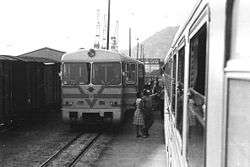Narrow-gauge railways in Bosnia and Herzegovina

Most Bosnian-gauge railway lines were built during the Austro-Hungarian Empire. Several 760 mm (2 ft 5 15⁄16 in) gauge railways were planned in order to link the extensive narrow gauge railways in the Austro-Hungarian Empire with those in Bosnia and Herzegovina. Until the outbreak of the Balkan Wars in 1912 several were constructed.
Between World War I and World War II the network was extended significantly, at the end connecting the Adriatic Coast with Belgrade, with the network growing to around 1500 km in length.
Construction of a new standard-gauge line from Sarajevo to Ploče on the Adriatic in 1966 replaced the 760 mm (2 ft 5 15⁄16 in) Narentabahn from Sarajevo to the coast and had the effect of isolating the south-western narrow gauge system from the 760 mm (2 ft 5 15⁄16 in) railways starting at Sarajevo. With the demise of a connecting network all the other remaining narrow gauge lines were then at risk and restricted to local traffic.
The system based on the Adriatic closed in 1975. By 1979 the rest of the Bosnian lines had closed. In Serbia the last 760 mm (2 ft 5 15⁄16 in) line closed in 1983. The most modern diesel railcars were sold to the Portuguese Railways (where they regauged to metre gauge for use on the Douro Valley metre gauge lines, such as the Tua line), becoming Portuguese train type 9700.
Central 760 mm (2 ft 5 15⁄16 in) gauge network
Steinbeis railway
Approximately 400 km, 1902–75.
Built as a forest railway of the "Bosnische Forstindustrie AG Otto Steinbeis".[1]
- Prijedor–Srnetica–Drvar–Lička Kaldrma–Knin (Croatia)[2]
- Branch: Srnetica–Jajce (to Sarajevo via the Spalato railway)
- Branch: Srnetica–Gornji Ribnik
The Lička Kaldrma–Knin line was converted to standard gauge and incorporated in the "Unska pruga" route in 1948.
With connecting forest railways near Grmeč, Klekovača, Oštrelj, Manjača and Glamoč.[3]
Spalato railway
Spalato Bahn (Splitska pruga); 104.5 km, built 1893–95, Connecting the Steinbeis railway with the Bosna railway to Sarajevo.[4]
- Lašva–Travnik; 30.1 km, 1893
- Travnik–Donji Vakuf–Bugojno; 70.7 km, 1894, including 14.1 miles (22.7 km) of Abt rack railway over the Komar mountain pass
- Donji Vakuf–Jajce; 33.7 km, 1895 (further to Srnetica on the Steinbeis railway)
- Bugojno–Aržano–Split; (Planned, never built)
Bosna railway
Bosnabahn (BHStB), 355.2 km
- Bosanski Brod–Doboj–Zavidovići–Zenica–Lašva, Podlugovi–Vogošća–Sarajevo; 268.2 km, built 1879–1882, connection to the Spalato Railway at Lašva, as well as the East Bosnian railway and the Narenta railway at Sarajevo.[5]
- Branch: Doboj–Karanovac–Simin Han, 66.7 km, built 1886; Branch Karanovac–Gračanica, 6.0 km, built 1898.
- Branch: Zavidovići–Olovo
- Branch: Podlugovi–Vareš, 24,5 km; Čevljanović–Ivančići, 1.9 km
- Branch: Vogošća–Čevljanovići; 20.3 km built 1885.
Narenta railway

Narentabahn (Neretvanska pruga); 178.4 km, constructed 1885 – 1891.
- Metković–Čapljina–Gabela–Mostar; 42.4 km, 1885 (Gabela is a junction with the Dalmatian railway)
- Mostar–Ostrožac; 65.9 km, 1888
- Ostrožac–Konjic; 13.0 km, 1889
- Konjic–Ivan pass–Ilidža–Sarajevo; 55.8 km, 1891 (including 18.8 miles (30.3 km) of Abt rack railway over the Ivan mountain pass, replaced with a tunnel in 1931, having a standard gauge railway structure gauge). Connecting with the Ostbahn and the Bosna railway at Sarajevo.
- Branch: Gabela–Metković–Ploče; 1942 extension to a planned sea harbour in Ploče.
- Branch: Ilidža–Ilidža-Banja; 1.3 km, built 1892.
Dalmatian and Zelenika railway
Dalmatiner Bahn (Dalmatinska pruga); 188,6 km, built 1901.[6]
- Gabela−Hum–Uskoplje–Herceg Novi (Montenegro)–Zelenika; 155,5 km (Gabela Junction–Narenta railway (Sarajevo))
- Hum–Trebinje, 17 km, built in 1901 and extended to Bileća in 1931 (37 km), Nikšić (Montenegro) in 1938 (71 km) and further to Podgorica in 1948 (56 km).[7]
- Branch: Uskoplje–Dubrovnik; 16,5 km
East Bosnian railway
.jpg)

Bosnische Ostbahn (Bosanska istočna pruga) 166.4 km, built 1906.[8]
- Sarajevo–Pale–Ustiprača–Međeđa–Uvac 137,6 km (Serbian border); Uvac-Priboj, Serbia (built 1929). This line is connected to the Bosna railway and the Narenta railway at Sarajevo.
- Međeđa–Višegrad–Dobrun 21,5 km; Dobrun–Vardište 7.3 km (Serbian border); Vardište–Mokra Gora–Šargan Vitasi–Užice (built 1925); Užice–Čačak (built 1912); Čačak–Gornji Milanovac (built 1920); Gornji Milanovac-Lajkovac (built 1922); Lajkovac–Obrenovac (built 1908); Obrenovac–Belgrade (built 1928).[9]
- Ustiprača–Foča–Miljevina 56 km (built 1939)
In the 1960s, plans were made to regauge the lines to normal gauge. However, this was not realised. On 28 May 1978 the line was closed for commercial traffic.
The track bed is currently quite well visible in the landscape, with several stations, tunnels still visible. A small part of the track is still in service as a heritage railway rebuilt between 1999 and 2003, Šargan Eight.
Other
Bosanska Mezgraja–Bijeljina railway
Bosanska Mezgraja–Ugljevik–Modran–Bijeljina
An isolated 760 mm (2 ft 5 15⁄16 in) gauge railway.
Sinj railway
Split–Sinj (completed in Croatia); 40 km, 1903–62. A planned extension via Aržano to Bugojno (and further on existing tracks to Sarajevo) never materialized because of World War II and the line remained isolated from the Bosnian 760 mm (2 ft 5 15⁄16 in) network.[10]
Banovici coal-mine railway
A 760 mm (2 ft 5 15⁄16 in) gauge industrial line opened in 1947 near Tuzla.[11] Still in commercial operation.
Gračanica–Karanovac
Gračanica–Karanovac; 4 km, 760 mm (2 ft 5 15⁄16 in), 1898–1967[12]
See also
External links
- The 76cm gauge railways of Yugoslavia
- The Bosnian Ostbahn – Illustrated guide (German, downloadable PDF with route maps)
References
- ↑ Steinbeis-Bahn
- ↑ The Steinbeis railway in 1965 by Charlie Lewis
- ↑ Die Steinbeisbahn
- ↑ Spalato bahn
- ↑ Bosna Bahn
- ↑ Zelenika Bahn
- ↑ Zur Eisenbahngeschichte von Montenegro
- ↑ Bosnische Ostbahn
- ↑ "Uskotračne željeznice - Grafikoni" [Narrow-gauge railways - Graphs]. zeljeznice.net (in Croatian). Retrieved 16 September 2016. (registration required (help)).
- ↑ Sinj Bahn
- ↑ Banovici coal mine
- ↑ Ukinuta željeznička pruga Karanovac – Gračanica
| Wikimedia Commons has media related to Former narrow gauge railways in Bosnia and Herzegovina. |